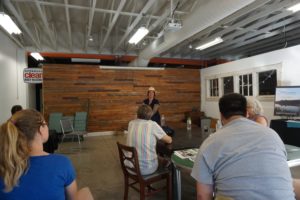I was fortunate to be invited to speak at a July 8, 2017 event at Central Print in St. Louis. It was organized to introduce a new river advocacy and resource book by Cole Williams, an author from St. Paul, MN. The book is titled Hear the River Dammed: Poems From the Edge of the Mississippi. Local author Dean Klinkenberg also read from his Frank Dodge mystery series. Below is the text of my short talk.
 |
 |
By Brad Walker, Rivers Director July 12, 2017
The Upper Mississippi River is an icon, but its image is misleading and distorted.
We like to think of the river as a tamed immortal giant constantly rolling past us, its history providing us with nostalgic stories.
The reality is something quite different.
The river is actually highly altered and degraded primarily due to two major activities:
- Damming and channeling the river for barges.
- Disconnecting the floodplains from the river for industrial agriculture.
The result today is a river that is not recreation-friendly, is increasingly devoid of native species, and is more flood-prone.
Although we have learned a lot about how this river can be helped, the river needs help in a much bigger way — unfortunately our current restoration efforts are financially and legally constrained:
- Funding is far too low.
- But more importantly, the law restricts restoration efforts from negatively impacting barge navigation. How ironic is that!
The perceived value of barges comes more from the minds of advertising experts paid for by the special interests who benefit from exploiting the river, rather than from actual scientific and economic evidence.
Barges are portrayed as environmentally positive:
- As mentioned earlier, the primary reason the UMR is degraded is the altering of the river to accommodate barges. That fact is conveniently ignored by the misinformation purveyors. The impacts from the construction and maintaining of the barge system costs the public billions of dollars each and every year in lost ecosystem benefits.
- Their talking points also state that barges are more fuel efficient and therefore they are less polluting. Yet railroads are actually significantly more fuel efficient than barges north of St. Louis and about equally efficient below the city.
Barges are also peddled as being cheaper than other transport modes:
- Railroads may be slightly more expensive for customers near the river, but those customers benefit from a large discount the barge industry receives because their rates are artificially reduced by the more than 90% subsidy of the system paid by the taxpayers.
- Annually, the barge industry contributes only about $100 million per year to construction and nothing to the operation and maintenance of their system, while the railroads invests between $10 and $15 billion each year to their system.
The public needs to get engaged and demand that their tax dollars be used wisely and productively on our rivers.
We need to support restoration efforts that are not limited by short-sighted laws that solely benefit special interests.
Ultimately, we must start putting the river back, removing the constrictions and opening up the floodplains. We will then all become the beneficiaries of a healthier and safer river that we can once again enjoy and create new stories about.
